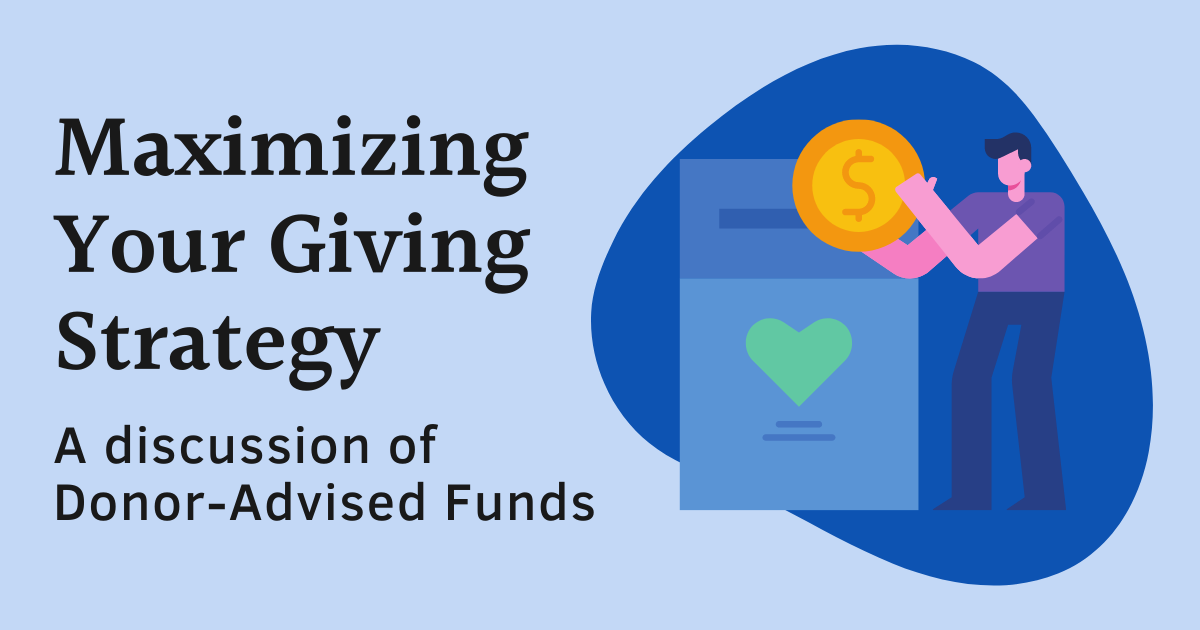The Tax Cuts and Jobs Act (TCJA) that was passed in 2017 changed several things in our tax code, but primarily it lowered federal taxes paid for most middle-class families. One of the ways it did this was by increasing the standard deduction a taxpayer receives and by capping the state and local taxes (SALT) that are deductible at $10,000. In 2022, the standard deduction is $12,950 for single filers and $25,900 for joint filers. For about 20 million American families, this changed their filing strategy from itemizing to taking the standard deduction every year. You may be thinking to yourself, “Great, I’m keeping more money in my pocket, and my taxes are simpler.” While this may be true, some families could benefit by “bunching” or “clustering” their charitable giving in one year instead of over several.
Enter the donor-advised fund (DAF).
Donor-Advised Funds
A donor-advised fund is an investment vehicle that is managed by a third party. This fund can allow you to make a large charitable contribution in one year and make smaller charitable disbursements over several years. One feature of the DAF is that the taxpayer realizes the tax benefit when the money goes into the account, whereas the smaller charitable distributions may have left one under the standard deduction.
DAFs are more user-friendly than charitable remainder trusts and private foundations and are relatively cheap to establish and maintain. Because of the tax law change and the ease of use, there was a 19% increase in individual DAFs between 2018 and 2019, bringing the total number of DAFs to 873,228 (The Tax Advisor, 2021). Let’s look at an example of how bunching your deductions a DAF could work:
Case Study*
John and Jane Smith enjoy giving to their church and other organizations in their local community. Last year, John received a $30,000 bonus at the end of the year, and they gave $18,000 or 10% of their income to their church and another $2,500 to local charities throughout the year. When they go to file their taxes, their accountant figures that even with their giving last year, the standard deduction of $25,900 was still higher than their itemized deductions. The Smiths do not get to deduct any of the $20,500 that was given to charities.
To maximize their tax situation, the Smiths could have taken the $30,000 year-end bonus and started a Donor Advised Fund to use for future giving. This will allow them to deduct the entire $50,500 charitable contributions ($30,000 initial contribution to the DAF + $18,000 to their church + $2,500 to various other charities) compared to their standard deduction and would save them $5,412 in federal taxes. In the following year, the Smiths will give out of their DAF instead of out of their checkbook.
Items to Consider
- Donation amount: The minimum amount to open a DAF is typically $25,000 and the donor is usually limited to sending checks to their preferred charities larger than $100.
- Fees: It is important to understand all the costs that go into a Donor Advised Fund. The DAF will charge a fee to hold the assets, if you hire an advisor to manage the investments, they will charge a fee, and if the money is invested in a mutual fund or ETF, there is an annual expense ratio that the investment fund company charges. All told, the money inside the DAF could cost between 1.0% – 3.0% of the total assets in the DAF.
- Ownership: Once the money goes into a DAF, technically the assets no longer are owned by the donor. The funds that go into the Donor Advised Fund are irrevocable. The donor can advise which charities receive the grants but cannot reverse the gift back to themselves.
- Type of Asset: Be sure the donor-advised fund can accept the asset you wish to donate. Not only can you set up a DAF with cash, but it may be possible to open a DAF with highly appreciated assets such as a stock, real estate, or a business.
- Income Gains: DAFs work great for someone who wants to frontload a charitable contribution to offset a windfall such as the sale of a business or property
If you are looking for ways to give back to some of the non-profit organizations that you are passionate about and want to make sure you are taking full advantage of the potential tax savings, don’t hesitate to give us a call.
*This is a hypothetical example and is for illustrative purposes only. It is not representative of any specific situation. Your specific situation may vary. We encourage you to seek personalized advice from qualified professionals regarding all personal finance, tax, and legal issues.
Content in this material is for general information only and not intended to provide specific tax, legal, or investment advice or recommendations for any individual. Strategence Capital and LPL Financial do not provide tax or legal advice or services. Please consult your tax and legal advisors regarding your specific situation.

